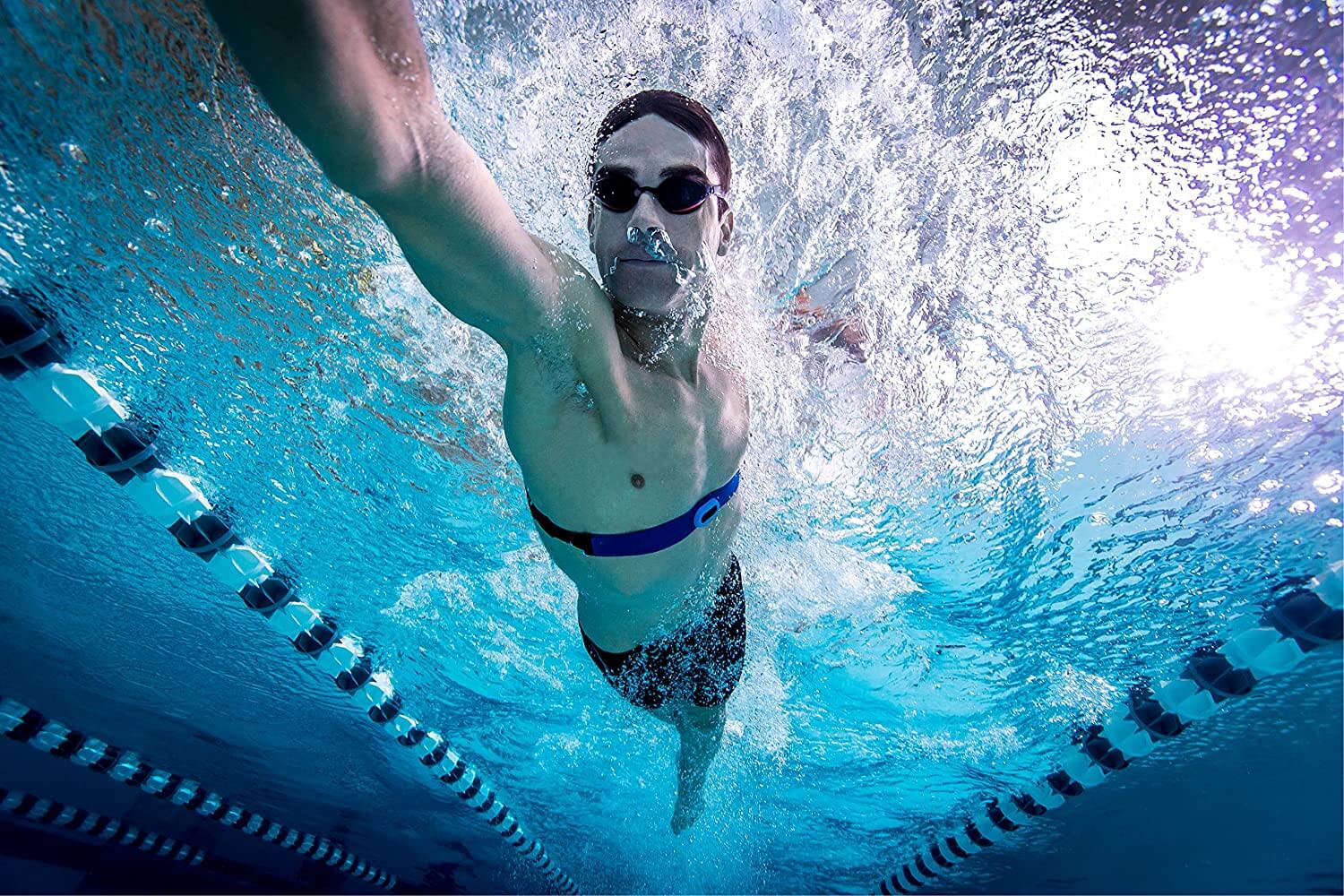Designed with athletes in mind, Garmin’s heart rate monitors are one of the best in the industry. And we’re not talking strictly about smartwatches. In fact, if you want to take your fitness game to another level, you might want to give their chest straps a go this year. Recommended for professional runners or swimmers, these devices can elevate your workout in an instant. Here’s what to choose, how they work and how to use the Garmin heart rate monitor for you.
Garmin Heart Rate Monitor: Chest Strap or Smartwatch?
If you’ve only thought of heart rate monitoring as a basic fitness feature in a smartwatch, then you might now know exactly why are chest straps needed or used. Moreover, you might be missing the key difference between them – the way they work.
Polar became the name associated with chest straps in the 70s that looked like elastic loops with inner contact points and an outer transmission unit. These worked by measuring electrical impulses sent by your heart through ECG.
In time, and once optical sensors became a commodity, manufacturers began playing with different forms of heart rate monitors, trying to make them easier to carry and use. Forearm straps hit the market as well as wrist ones.
From there it was easy to imagine a device that could do both – keep time and act as a heart rate monitor, among other things. Hence, the smartwatch.
Unlike the chest strap, a smartwatch relies on optical sensors. These shine a light onto the skin and measure the variance in blood flow resulted.
Since chest straps are worn tightly around the user core, they are a bit more accurate than wrist devices. Smartwatches, for example, can slip and the optical sensor briefly lose contact with the skin over rough terrain, resulting in a flawed reading.
Garmin offers the best of both worlds – chest straps that are easy to adjust and don’t slip and smartwatches that are enhanced with sleep tracking and stress information, oxygen saturation data and other health information.
How To Use the Garmin Heart Rate Monitor
While smartwatches with heart rate monitoring are extremely intuitive, chest straps require a bit more work.
To get an accurate result from a smartwatch, you simply put it on, tap a button or two and let the companion app do its thing.
Chest straps, however, have to be carefully considered. These come in different configurations. To use a Garmin heart rate monitor in the form of a chest straps, you have to think about:
- comfort: is a slimmer or a wider strap better for you during a run or swim?
- look: would a smaller or bigger module size fit with your workout clothes?
- built-in memory: while you can see maximum heart rate, heart-rate variability and target heart rate on your companion app (phone) any time, storing the data on device during a workout might be what you need if you have bringing your handset along
- basic or high-end: basic models might offer your just heart rate readings while higher-end options go the extra mile and can show stride length, calorie burn, blood pressure
- battery: can you live with a non-rechargeable, long-lasting battery or do you need a rechargeable one?
How Does the Garmin Heart Rate Monitor Work?
Garmin smartwatches work on a patented technology comprised of an emitter, receiver, inertial sensor, and time-variant sensor.
If you’re curious about the way the tech measures your heart rate, the process goes like this. It all starts with the processor that determines the frequency associated with the motion signal. Then it turns it from PPG into the frequency domain with the intent to identify the cardiac component of the PPG signal.
That’s done by using a bandpass filter to let only signals within the range of possible cardiac component frequencies pass by.
Once the cardiac component is identified, the processor can determine filter coefficients for the cardiac component which are configured into the time-variant filter.
Now, the PPG signal is turned back into the time domain and filtered by the time-variant filter. The motion component is removed and the time between cardiac component cycles, calculated.
This time can give you clues about the heart rate variability, recovery time, VO2 max, even sleep quality. Of course, those clues appear on an interface designed to explain the health status to the user.
From here, you can understand if you’re in the heart zone you were hoping for, your exertion level and what can you do to improve your workout. Plus, it can help you understand hydration levels and the whether a longer recovery time is needed.
Fitbit Trackers, Able To Check Heart Rhythm in the Background
Best Heart Rate Monitors
Now that you know a bit more about the heart rate monitors available to you, maybe you’re looking for some recommendations. We have listed below some of the best from Garmin, be it a snug chest strap or a versatile smartwatch.
Garmin HRM-Swim for Swimmers

This chest strap was specifically designed for swimmers. It’s the lightest and smallest from the Garmin collection, crafted for no drag while swimming.
The company says you can safely wear it in pools as well as salt or fresh water. During swims, the strap captures 20 hours of heart rate data and transfers it to a compatible device for your convenience.
If you use it about 3 hours per week, the battery should last for a year and a half (18 months).
⫸ GET IT HERE
Garmin Forerunner 945 for Cycling

The Forerunner 945 will give you the most advanced heart rate data that its Elevate optical sensor can measure. And if that’s not enough, you can even pair it with a dedicated HRM strap.
In the second case, those optical sensors will be left to work on tracking respiration rate (24/7), VO2 Max, Pulse Ox, and get you valuable insight. The smartwatch will send abnormal heart rate alerts and give you an idea of your Body Battery (level of energy).
⫸ GET IT HERE
Garmin HRM-Run for (duh!) Runners

While it’s not as lightweight as its swimming counterpart, this strap will still feel thin and comfortable.
It can capture cadence, vertical oscillation and ratio, ground contact time, stride length and left/right balance. As you can see, it’s the perfect companion for a serious runner! In fact, the battery was made to last for an entire year if you’re dedicated to running an hour every day.
So, if you’re still finding your motivation to run, this baby should give you extra incentive and last you longer than you think.
⫸ GET IT HERE
Garmin Lily Fitness Smartwatch

This smartwatch from Garmin is an affordable fitness tracker for women that can track wrist-based heart rate, daily resting heart rate, respiration and Pulse Ox. Besides finding out how your energy levels are, women can also monitor their menstrual cycle, pregnancy, up to 5 days/respiration, Pulse Ox (this is not a medical device), energy levels, menstrual cycle and pregnancy.
Like most current smartwatches, it will also provide insight into calories burned, steps taken and more.
⫸ GET IT HERE
Garmin Venu 2 Fitness GPS Smartwatch

This is the first Garmin watch to come with the Garmin Elevate 4 optical sensor. Basically, Garmin added more infrared sensors and sensor paths, so you can bet on a higher heart rate accuracy, better sleep tracking, and Pulse Ox insight.
Plus the smartwatch can monitor more than 25 indoor sport modes and store up to 650 songs for more entertaining workout sessions.
⫸ GET IT HERE
Garmin Fēnix 6 Pro

This is one of the more high-end Garmin smartwatches available on the market. It not only offers the best in tracking technology but is able to track heart rate underwater without a heart rate strap.
It’s definitely a smartwatch for the adventurer in you with access to multiple global navigation satellite systems and a 10-hour battery life. It also can store up to 2,000 songs, a big uptake from the Venu 2.
⫸ GET IT HERE
Affiliate disclosure: We may receive compensation in connection with your purchase of products via links on this page. The compensation received will never influence the content made on this website.
Can You Trust It? How Accurate is Apple Watch Calories Tracker
Garmin Forerunner 45S Wants to Do a Lot on a Budget and Mostly Succeeds [Review]
Follow TechTheLead on Google News to get the news first.
























Paul
April 16, 2022 at 12:50 pm
Where’s the hrm-pro in your list? It’s better then both the run and the swim, works on both BLE and ANT+ !